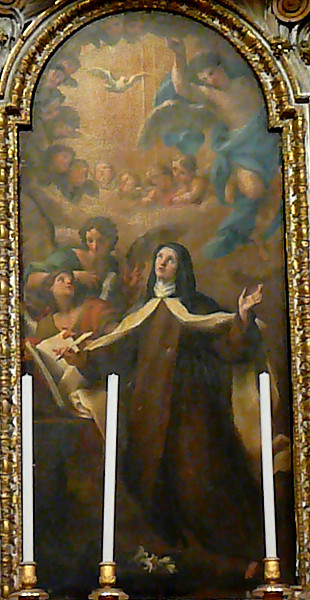The book and pen refer to the Teresa's authorship of a number of important books arising from her experiences as a mystic and a reformer of convent life. She entered the Carmelite convent of the Incarnation in Ávila at the age of 20, but after a number of years was dissatisfied with the lax practices there. With the help of her confessor and others, she started a small community devoted to a very strict observance, including perpetual abstinence and nearly perpetual silence. Soon she was asked to start similar communities in other cities. Her Way of Perfection and Interior Castle were intended to help her charges to pursue a life closer to Jesus. She also wrote an autobiography at the request of her confessor.1
The basis for St. Teresa's work as a reformer was her mystical experience of the presence of Jesus. In one such experience she felt her heart pierced by an angel's spear:
I saw in his hand a long spear of gold, and at the iron's point there seemed to be a little fire. He appeared to me to be thrusting it at times into my heart, and to pierce my very entrails; when he drew it out, he seemed to draw them out also, and to leave me all on fire with a great love of God. The pain was so great that it made me moan; and yet so surpassing was the sweetness of this excessive pain that I could not wish to be rid of it.2This experience is the subject of Bernini's famous sculpture (at right) and of numerous paintings. Most portraits opt for the book-pen-dove iconography, but I did find one that identifies the saint by putting a pierced heart on her breast.
In the first picture at right a squarish construction sits atop Teresa's veil. It resembles the object on her head in a Mexican nun's badge, which a correspondent has identified as a reference to the city walls of Ávila. In this santo in Mexico, the construction has been reduced to just a flat square like a graduation cap.
Prepared in 2015 by Richard Stracke, Emeritus Professor of English, Augusta University. Revised 2017-01-30, 2017-02-08.
HOME PAGE

A santo of St. Teresa at Mission San Juan Capistrano (See the description page)

Mancini painting, 18th century (See description page)

Bernini sculpture, 1647-52 (See description page)
MORE IMAGES
- 1697: Heinrich Meyring's Ecstasy of St. Teresa of Ávila resembles Bernini's more famous work.
- Circa 1700: Niccoló Bambini's The Consecrated Host Flies to St. Teresa.
- 1700: Holyguín's St. Peter Alcántara and St. Teresa of Ávila.
- 1722-24: Tiepolo's Glory of St. Teresa in the Scalzi Cburch, Venice.
- 1739: Statue in Oviedo, Spain
- 1748: G. B. Tiepolo, The Virgin Appears to SS. Agnes of Montepulciano, Rose of Lima, and Catherine of Siena.
DATES
- Feast day: October 15
- Born in 1515, died in 1582
NAMES
- Sometimes called St. Teresa of Jesus.
- Members of her order are called "Discalced" ("shoeless") Carmelites because they wear sandals rather than shoes.
MAJOR WORKS
BIOGRAPHY
- Roman Breviary (1908 English translation), IV, 655-56
- Acta Sanctorum, October vol. 7, 109-790